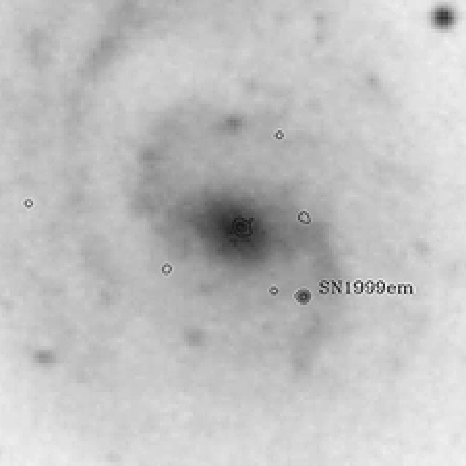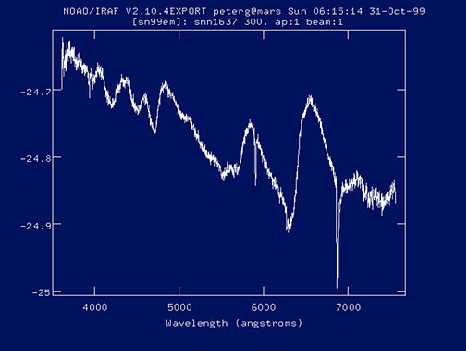 |
We reprint the following article from ``Chandra Chronicles:"
http://chandra.harvard.edu/chronicle/1099/treat.html
It is a behind the scenes look at how a Target of Opportunity (TOO) is put together. Although many TOOs have been done by Chandra since this one, the process is pretty much the same. Enjoy the scramble!
Editor
November 2, 1999: Cambridge, MA
It all started on Friday, October 29, when Alex Filippenko of the University of California at Berkeley notified Bob Kirshner at Harvard-Smithsonian that his supernova search project had a good candidate in a relatively nearby spiral galaxy, NGC 1637 (Figure 6.) Nearby in this case means about 25 million light years from Earth. Wei Dong Li, who is visiting Filippenko's group from the Beijing Astronomical Observatory, called his colleagues in Beijing, who confirmed the supernova, which was given the official name, SN1999em. Kirshner's group at the Smithsonian's Whipple Observatory in Arizona took a spectrum of the object on Saturday. The spectrum showed that the object was a Type II Supernova, an explosion produced by the collapse of the core of a massive star (Figure 7.)
 |
Kirshner took time off for dinner on Saturday night, then got in touch via e-mail with Harvey Tananbaum, director of the Chandra X-ray Center a little before 11 p.m. ``There's a bright supernova in NGC 1637," he said. After giving some of the details, Kirshner signed off, ``Explosively yours, Bob."
The discovery presented a dilemma for the Chandra team. On the one hand, a supernova this close to Earth goes off only once every five or ten years, and it would be the first time ever that an X-ray telescope with Chandra's sensitivity had looked at a new supernova. It definitely qualified as a Target of Opportunity (TOO) for which the normal observing program could be interrupted so Chandra could look at some new occurrence in the sky. On the other hand, the TOO program was not scheduled to begin until the Chandra Center had had more experience learning about the quirks of the observatory and the software used to command it.
Tananbaum decided to go for it, pending a review by various experts on the risks and rewards of such an undertaking. Shortly after 9:00 a.m. on Sunday, Tananbaum sent an e-mail to key team members, asking for their input.
Pat Slane of the Chandra Science Mission Planning group (Figure 8) was the first to respond, and he passed the word along to Bill Forman, the head of Science Mission Planning. Soon, e-mails and phone calls were zipping back and forth as the pros and cons of the observation were discussed, and the scientists juggled their children's Halloween party schedules. Slane managed to attend his child's party and stay in touch. (He went as a vampire with a cell phone).
At 9:59 a.m. Roger Brissenden, manager of the Chandra Center, weighed in with practical considerations such as pointing problems and the details as to how to interrupt the ``load" -- the program that is sent up to direct Chandra's operation for a week. Ken Gage or Kevin Marsh of the Flight Ops team would have to be brought in to write the necessary software to do this.
At 10:29 a.m. Walter Lewin of MIT, who had won the rights to Chandra's first observation of a nearby supernova, urged Tananbaum to ``... go for this one! A unique chance that we have been hoping for!!!!"
At 10:59 a.m. Paul Plucinsky of the Chandra Center's ACIS team passed along useful information on ACIS, the instrument that would be used for the observation.
At 11:30 a.m. Li supplied an accurate position of the supernova.
At 11:42 a.m. Forman emphasized the need to carefully review the procedures to maintain spacecraft safety. Anil Dosaj (Figure 9) volunteered to come in and prepare the official Operation Request, or OR file for the observation.
At 3:42 p.m. Dosaj notified Tananbaum that they could replace the load by 2 a.m. Monday morning.
For the next 5 hours the team worked furiously, with Lewin and his colleague Derek Fox consulting with Plucinsky and Royce Buehler of MIT's ACIS team to plan the details of the observation. When they were finished, Brissenden called the team together for a final review at 9 p.m. Present were Jeff Shirer (TRW's Flight Operations Team), Rob Cameron (Aspect Camera), Buehler (ACIS), Jon Chappell and Gerry Austin (HRC), Dosaj, Slane, Forman, and Marsh (Figure 10.)
``I was impressed by how rapid the Chandra response was..."
- Dr. Robert Kirshner from the Harvard-Smithsonian.
``The review is complete and there are no issues," Brissenden reported to Tananbaum. ``Overall a good effort from the team in my opinion."
All that remained was to wait for the time slot to uplink to Chandra -- most of Monday -- and for Chandra to slew over to the source -- about half an hour.
For the results, see:
http://chandra.harvard.edu/photo/sn1999em/
- Wallace Tucker, Karen Tucker, and Kim Kowal